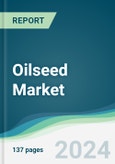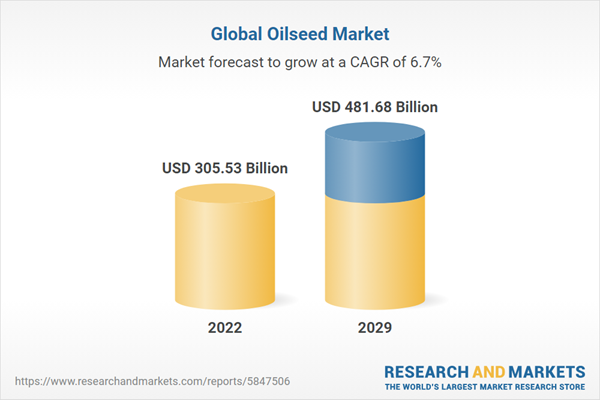The oilseed market is projected to grow at a CAGR of 6.72% to reach US$481.683 billion in 2029 from US$305.526 billion in 2022.
Oilseeds and oilseed meals can provide nutrients that promote milk synthesis and development. When using heat-treated oilseeds or oilseed meals, it is essential to apply the proper heat treatment to provide the optimum preservation of amino against ruminal enzyme deterioration and inhibition of organically present enzymes that impede ingestion. Due to their nutritional profiles, oilseed crops' byproducts (such as hull, meal, and oil) have been incorporated into the diets of both humans and animals. Most oilseed meals are made up of proteins and have high levels of essential amino acids. Several industrial products utilize oilseeds, including biodiesel, fertilizer, medications, cosmetics, animal feeds, fibers, paint, buttons, etc. Growing demand for livestock nutrition coupled with utility in various applications and adoption of healthy lifestyle has propelled the market growth at global scale.Market Drivers
The expanding utilization across various applications is stimulating the market growth.
Fatty acids, oil, minerals, protein, vitamins, and fiber are all abundant in oilseeds and are frequently employed in extracting oil. The nutrient-rich pulp left behind after soybean oil extraction is turned into meals or oilcakes and fed to dairy farm animals to increase milk production and quality while reducing feed requirements. Oilseeds are highly sought-after due to their numerous uses. In cosmetic goods, oil seeds like sunflower are utilized as a moisturizer. People are choosing vegetable oil over animal fat because they prioritize their health more. The market is also being driven by government initiatives to produce oilseeds more effectively. According to Indian government reports, the Ministry of Agriculture and Farmers Welfare's National Mission on Oilseeds and Oil Palm (NMOOP) continues to oversee domestic oilseed policy. By 2022, the National Mission expects nine oilseed crops produced on 31.2 million hectares to produce 45.64 MMT of domestic oilseeds.Growing applicability in sustainable aviation fuel has bolstered the market growth.
Oilseed includes crops that form an integral part of sustainable aviation fuel production, thereby reducing the overall carbon emission. The growing emphasis to limit conventional kerosene in efforts to reduce the global carbon footprint has accelerated the need for sustainable aviation production which is expected to pave the way for future market growth for oilseed. Various investments and research activities are being undertaken. For instance, The U.S. Department of Energy awarded US$2 million in financing to researchers at Michigan State University in December 2022. These researchers are trying to develop cleaner, more sustainable biodiesel and jet fuels from Camelina sativa, a plant related to cabbage and cauliflower. This data will assist scientists in understanding the plant's oilseed production and make it a more competitive substitute for the current petroleum-based fuels that meet aviation requirements.Soybean and sunflower seeds accounted for a dominant share by crop type.
In terms of crop, the sunflower category accounts for a sizable portion of the oilseeds market due to its extensive use in biofuel creation. Sunflower oil is also widely consumed by consumers due to its high nutritional value and health advantages, as it includes omega-6 fatty acids. Sunflower seeds are also commonly used in powder form, which increases demand for the sunflower oilseed market. Furthermore, the consumption of soybean oil has increased as a result of the rise in the health-conscious nature of people. Because of the nutritional benefits of soybeans, the demand for them in the food business has grown over time. This has led to an increase in the production of soybean oil, which has fueled the expansion of the oilseed market for soybean.The Asia Pacific region is expected to witness the highest growth rate among regional markets.
Due to rising personal disposable income, expanding food processing industries, and the region's retail sector, Asia-Pacific is anticipated to experience the fastest growth in the oilseeds market over the projection period. Moreover, due to the growing number of technical developments, China is also predicted to expand at a healthy rate in the Asia-Pacific oilseeds market. The country is witnessing new collaboration to bolster its foreign trade, for instance, in December 2022, at the Dalian Commodity Exchange (DCE) in Dalian, Liaoning province, eight soybean-related futures and options, including No. 1 soybean, No. 2 soybean, soybean meal, and soybean oil, were formally opened to foreign traders. China is a significant producer of non-GMO soybeans globally and a substantial market for GMO soybeans.North America holds a sizeable percentage of the world's oil seed market due to the expansion of oilseed production and the rise in the usage of edible oils in the daily lives of Americans. Additionally, the U.S. soybean crop was produced in greater quantities, which led to rising soybean oil consumption and further accelerated market expansion. The World Trade Organization reports that the United States is the second-largest exporter and one of the leading producers of soybeans worldwide.
Key Developments
- In March 2023: Chevron USA, Bunge, and Corteva Inc. formed a strategic collaboration for the development of winter canola hybrids and used the same for making low-carbon profile plant-based oil. The new production aims to meet the demand for growing low-carbon renewable fuels.
- In August 2022: Bayer formed a shareholder’s agreement along with Chevron USA and Bunge where the former would acquire a 65% stake in winter oilseed producer CoverCress Inc. whereas Bunge and Chevron will have joint ownership of the remaining 35%.
Segmentation:
By Crop Type
- Canola
- Rapeseed & Mustard
- Soybean
- Sunflower
- Others
By Type
- GMO
- Conventional
By Geography
- North America
- USA
- Canada
- Mexico
- South America
- Brazil
- Argentina
- Others
- Europe
- Germany
- France
- United Kingdom
- Spain
- Others
- Middle East And Africa
- Saudi Arabia
- Israel
- Other
- Asia Pacific
- China
- Japan
- India
- South Korea
- Indonesia
- Taiwan
- Others
Table of Contents
1. INTRODUCTION
2. RESEARCH METHODOLOGY
3. EXECUTIVE SUMMARY
4. MARKET DYNAMICS
5. OILSEED MARKET BY CROP TYPE
6. OILSEED MARKET BY TYPE
7. OILSEED MARKET BY GEOGRAPHY
8. COMPETITIVE ENVIRONMENT AND ANALYSIS
9. COMPANY PROFILES
Companies Mentioned
- BASF SE
- Bayer AG
- Bunge Limited
- KWS SAAT SE & Co. KGaA
- Syngenta
- Corteva
- Cargill
Methodology

LOADING...
Table Information
| Report Attribute | Details |
|---|---|
| No. of Pages | 137 |
| Published | February 2024 |
| Forecast Period | 2022 - 2029 |
| Estimated Market Value ( USD | $ 305.53 Billion |
| Forecasted Market Value ( USD | $ 481.68 Billion |
| Compound Annual Growth Rate | 6.7% |
| Regions Covered | Global |
| No. of Companies Mentioned | 7 |









